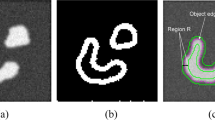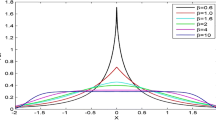Abstract
Segmentation is an important research area in image processing and computer vision. The essential purpose of research work is to achieve two goals: (i) partition the image into homogeneous regions based on certain properties, and (ii) accurately track the boundary for each region. In this study, we will present a novel framework that is designed to fulfill these requirements. Distinguished from most existing approaches, our method consists of three steps in the segmentation processes: global region segmentation, control points searching and object boundary tracking. In step one, we apply Markov Random Field (MRF) modeling to multi-channel images and propose a robust energy minimization approach to solve the multi-dimensional Markov Random Field. In step two, control points are found along the target region boundary by using a maximum reliability criterion and deployed to automatically initialize a Minimum Path Approach (MPA). Finally, the active contour evolves to the optimal solution in the fine-tuning process. In this study, we have applied this framework to color images and multi-contrast weighting magnetic resonance image data. The experimental results show encouraging performance. Moreover, the proposed approach also has the potential to deal with topology changing and composite object problems in boundary tracking.
Similar content being viewed by others
References
N.R. Pal and S.K. Pal, “A Review on Image Segmentation Techniques,” Pattern Recognition, vol. 26,no. 9, 1995, pp. 1277-1294.
Dongxiang Xu and Jenq-Neng Hwang, “A Topology Independent Active Contour Tracking,” in IEEE International Workshop on Neural Networks for Signal Processing, Madison, USA, Aug. 23–25, 1999.
J. Besag, “Spatial Interaction and the Statistical Analysis of Lattice Systems,” Journal Royal Statistics Society B, vol. 36,no. 2, 1974, pp. 192-236.
T. Meier, K.N. Ngan, and G. Crebbin, “A Robust Markovian Segmentation Based on Highest Confidence First,” in ICIP, Santa Barbara, Oct. 1997.
T.N. Pappas, “An Adaptive Clustering Algorithm for Image Segmentation,” IEEE Trans. on Signal Processing, vol. 40,no. 4, 1992, pp. 901-914.
S. Geman and D. Geman, “Stochastic Relaxation, Gibbs Distributions, and the Bayesian Restoration of Images,” IEEE Trans. on PAMI, vol. PAMI-6,no. 6, 1984, pp. 721-741.
M. Kass, A. Witkin, and D. Terzopoulos, “Snakes: Active Contour Models,” International Journal of Computer Vision, 1988, pp. 321-331.
L.D. Cohen and R. Kimmel, “Global Minimum for Active Contour Model: A Minimal Path Approach,” Int. J. of Computer Vision, vol. 24, 1997, pp. 57-78.
A.K. Jain, Fundamentals of Digital Image Processing, Englwood Cliffs, NJ: Prentice-Hall, 1989.
S. Clarke et al., “Multispectral Analysis of MR Images of Atherosclerotic Plaque: Correlation with Histology,” 8th Annual Meeting of ISMRM, Denver, USA, April 2000.
W.A. Wright, “Markov Random Field Approach to Data Fusion and Color Segmentation,” Image Vision Comput, vol. 7, 1989, pp. 144-150.
R.W.G. Hunt, Measuring Color, Chichester, England: Ellis Horwood, Ltd., 1987.
M.M. Chang, A.J. Patti, M.I. Sezan, and A.M. Tekalp, “Adaptive Bayesian Approach for Color Image Segmentation,” in SPIE Conference on Visual Communication and Image Processing, Boston, MR, Nov. 1993.
D. Comaniciu and P. Meer, “Mean Shift Analysis and Applications,” IEEE Int'l Conf. Computer Vision (ICCV'99), Kerkyra, Greece, 1999, pp. 1197-1203.
G. Wyszecki and W.S. Stiles, Color Science: Concepts and Methods, Quantitative Data and Formulae, 2nd edn., New York: Wiley, 1982, p. 113.
D.K. Panjwani and G. Healey, “Markov Random Field Models for Unsupervised Segmentation of Textured Color Images,” IEEE Trans. on PAMI, vol. 17,no. 10, Oct. 1995, pp. 939-954.
P.B. Chou and C.M. Brown, “The Theory and Practice of Bayesian Image Labeling,” Int. J. of Computer Vision, vol. 4, 1990, pp. 185-210.
J. Canny, “A Computational Approach to Edge Detection,” IEEE Trans. on PAMI, vol. PAMI-8,no. 6, 1986, pp. 679-698.
Dongxiang Xu and Jenq-Neng Hwang, “An Accurate Region Based Object Tracking for Video Sequences,” IEEE International Workshop on Multimedia Signal Processing, Copenhagen, Denmark, Sept. 13–15, 1999.
R. Lumia, G. Shapiro, and O. Zuniga, “A New Connected Component Algorithm for Virtual Memory Computers,” Computer Vision, Graphics and Image Processing, vol. 22, 1983, pp. 287-300.
R. Malladi, J.A. Sethian, and B.C. Vemuri, “A Topology Independent Shape Modeling Scheme,” SPIE Geometric Methods in Computer Vision II, vol. 2031, 1993, pp. 246-258.
Haiyan Wang and B.K. Ghosh, “Geometric Deformable Model and Segmentation,” in IEEE Intel. Conf. on Image Processing, Chicago, USA, 1998.
Author information
Authors and Affiliations
Rights and permissions
About this article
Cite this article
Xu, D., Hwang, JN. & Yuan, C. Segmentation of Multi-Channel Image with Markov Random Field Based Active Contour Model. The Journal of VLSI Signal Processing-Systems for Signal, Image, and Video Technology 31, 45–55 (2002). https://doi.org/10.1023/A:1014493104976
Published:
Issue Date:
DOI: https://doi.org/10.1023/A:1014493104976




